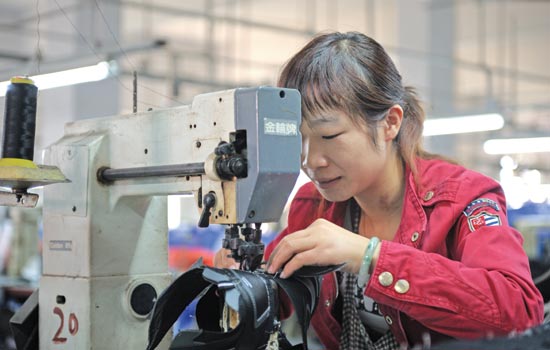|
 |
|
A worker at a shoe factory in Shaoyang, Hunan province. China had an output of more than 13 billion pairs of footwear last year, according to China Footwear Industry Association. [Photo/China Daily] |
Some look inland for lower costs, others build brands to add value
Rising costs and sluggish overseas demand are testing Chinese shoemakers' ability to maintain profits.
While some have moved to inland cities to take advantage of lower costs, others have enhanced their technology or "own brands" to achieve higher added value.
Zhang Huarong, who established Huajian Group in Dongguan, Guangdong province, in 1996, has been moving the company's manufacturing operations to inland cities such as Ganzhou in Jiangxi province and Xiangcheng in Henan province in recent years.
"Low labor and land costs as well as the favorable policies offered by the local government attracted us to Ganzhou," Zhang said.
Liu Qiongying, general manager of Chengdu Aiminer Leather Products Co Ltd, said profit margins in the shoe processing trade have been eroded in recent years by rising labor costs - up 20 percent annually in recent years - in addition to yuan appreciation and price fluctuations internationally.
Aiminer, established in 1996, saw its export value grow from $200,000 in 2001 to $50 million in 2011.
Rising costs in recent years have taken their toll on China's footwear manufacturers, who have done little to improve their core competitiveness through innovation, she said.
As a result, the industry is facing stiff competition from emerging markets such as India, Vietnam, Indonesia and Brazil , she added.
China, the world's biggest footwear maker and exporter, had an output of more than 13 billion pairs of footwear last year, or 65 percent of the world's total production, and exported about 10 billion pairs, 73 percent of total global exports, according to the China Footwear Industry Association.
But the industry saw a decline in orders in the first quarter of this year as increasing costs drove orders for low-end footwear to emerging markets, and the European debt crisis reduced overseas demand.
"The footwear industry is now standing at a turning point, a turning point for transformation and upgrading.
"We have to establish our own brands, high-end brands, because these are little affected by market fluctuations and downturns," Liu said.
Liu launched the women's shoe brand Sheme in 2009 to tap into China's high-end market.
Priced between 2,000 yuan ($314) and 8,000 yuan, Sheme is already available in Beijing and Chengdu, and is now entering the market in Shanghai, Shenzhen and Hong Kong.
"Establishing our own brand was a crucial move. The added value of a famous international brand could be 20 or 30 times the cost, and the brand can also bring pride to the company and the country," Liu said.
She said that the Sheme brand absorbed traditional Chinese cultural elements in fine art, architecture, opera and embroidery to enhance its standing as an international brand from China.
The brand's design group is composed of Italian footwear designer Leopoldo Giordano, Canadian footwear designer Dejan Djokovic, graphic artist Shine Cheung, and technical engineer Gianluigi Colombo, who has served as a technical adviser for Bally, Chanel and Fratelli Rossetti.
The company's research and development centers in Chengdu, Longquan and Guangzhou collect new styles and trends of shoes in order to ensure it keeps pace with international trends.
Sheme's products fall into three categories - traditional-style shoes made from silk, satin or fine cloth, shoes for special occasions encrusted with Swarovski crystals, and shoes for daily use.
"In order to ensure the high-quality of the brand, all the leather for the luxury shoes comes from Italy, while the silk and cloth is from China ," Liu added.
Liu said that the company sets such great store by investment in research and development that it took four years of operation for it to turn a profit.
"But we are confident that Sheme will rank alongside international brands such as Coach," Liu said.
In addition to investment, establishing overseas sales channels and winning recognition in overseas markets both take a long time.
The growing demand for quality from people under 30 is also a challenge for the brand, with people in this age group more likely to want unique or personalized designs, Liu said.
Despite the challenges, Liu remains optimistic about the prospects for the shoe industry, both at home and abroad.
Liu Xiang, the assistant to Liu Qiongying, said that, thanks to its mature technology, the company had an advantage over its peers, and this gave it the upper hand in building its own brands and making customized shoes.
In addition to Sheme, the company has another brand, Annastar, aimed at the medium- and low-end markets.
At present, the company remains engaged in processing, which is its major source of income and a major support for the company as it builds up its luxury brand.
Liu said the overseas market will remain the key one for Chinese footwear companies over the next 10 to 15 years.
"But demand for medium- and high-end shoes at home will steadily increase in the next five years as China stimulates domestic consumption and the middle class keeps growing," she said.
Instead of starting the difficult journey of building a high-end shoe brand, another domestic shoemaker, Sichuan Shangzhi Shoes Co Ltd, chose to remain in the processing trade as a maker of medium- and high-end women's shoes.
The company launched a new production line this year to meet overseas demand for high-quality products and offset the impact of falling orders.
The company is now making shoes for high-end brands including Clarks, Brown Shoes, and Bally, said Liu Chongshu, assistant to the company's general manager.
lijiabao@chinadaily.com.cn
